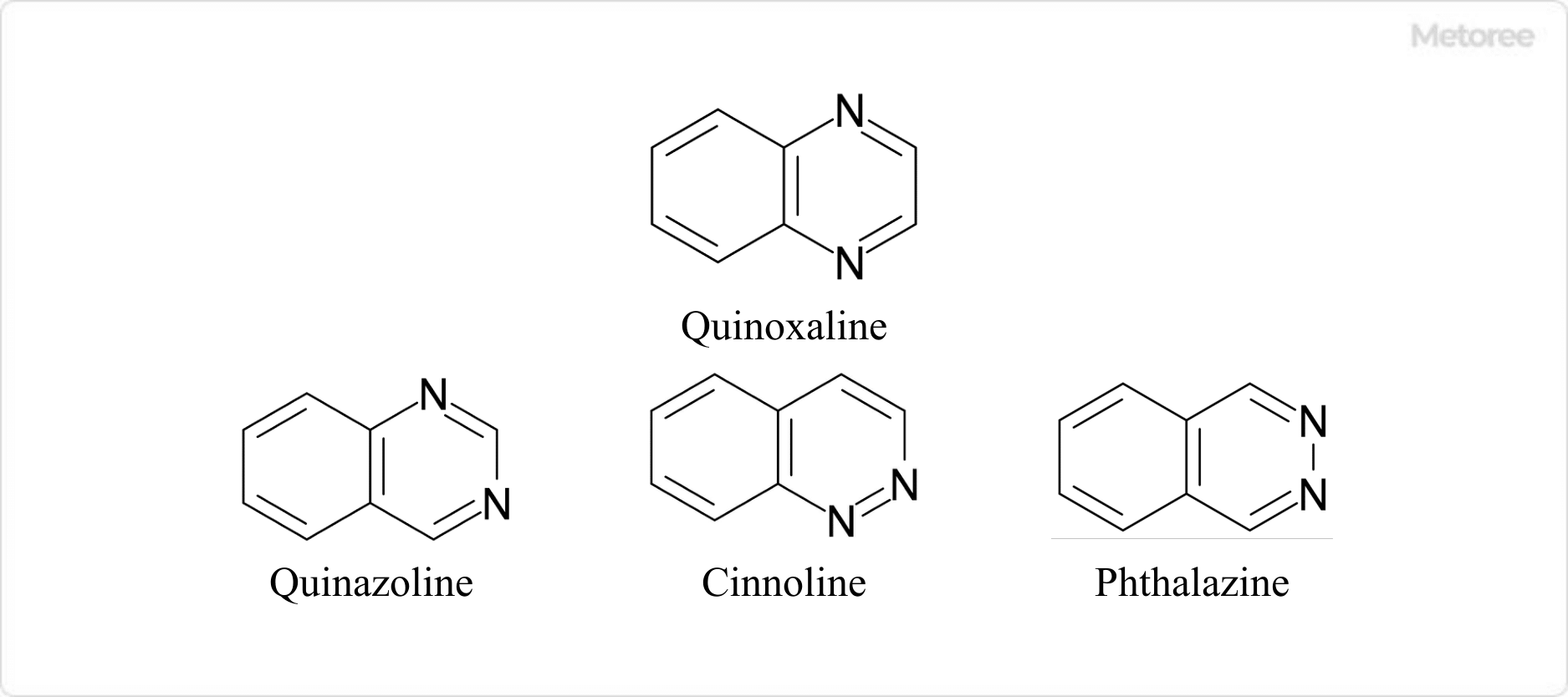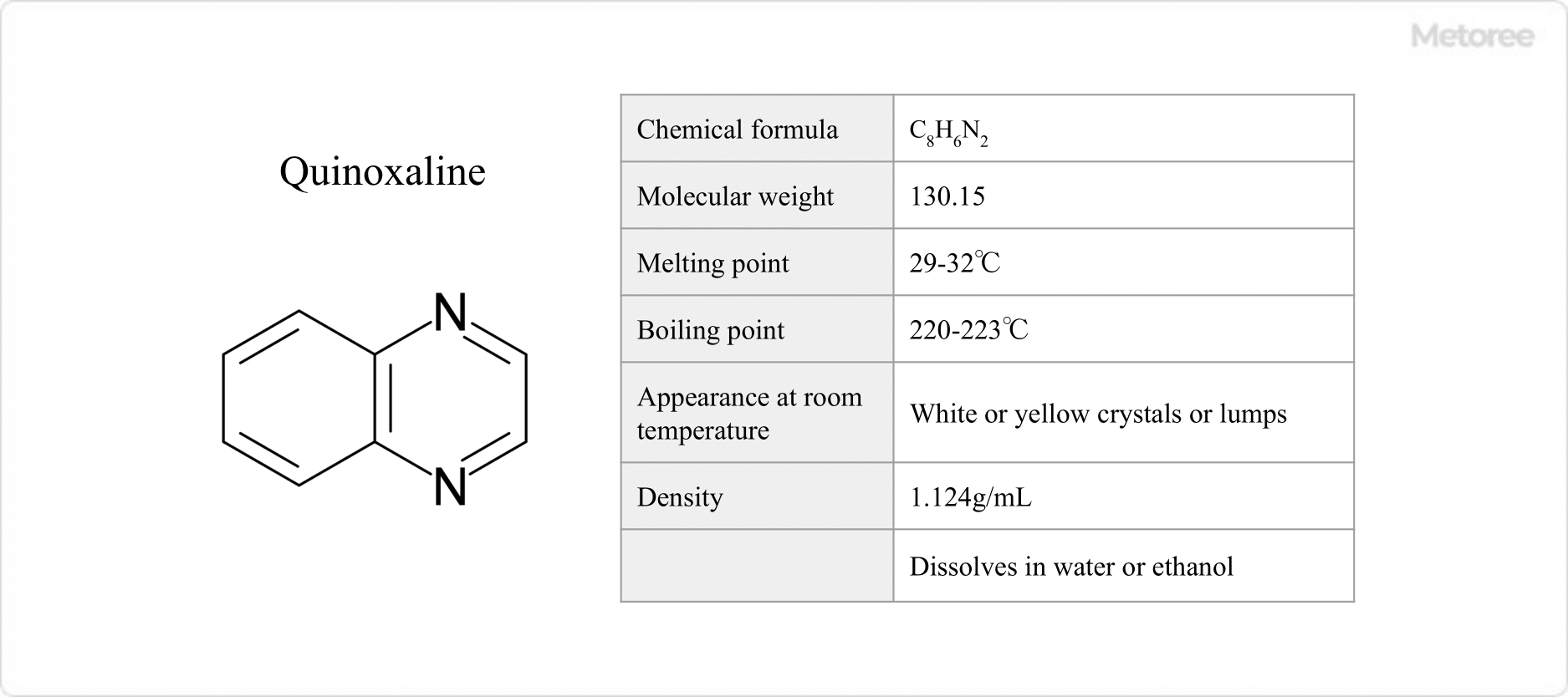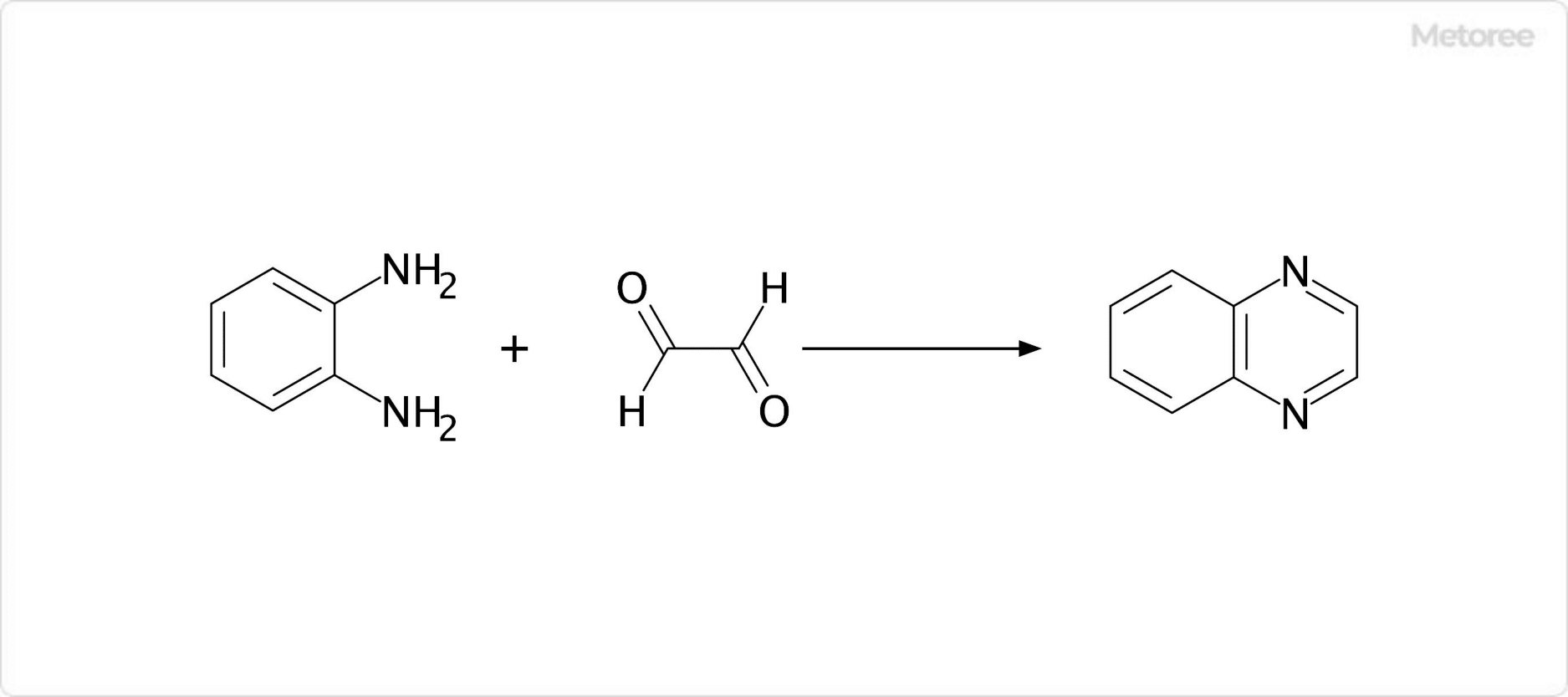All Categories
History






This section provides an overview for quinoxaline as well as their applications and principles. Also, please take a look at the list of 6 quinoxaline manufacturers and their company rankings. Here are the top-ranked quinoxaline companies as of December, 2025: 1.Toronto Research Chemicals, 2.Merck, 3.Tokyo Chemical Industry Co., Ltd..
Table of Contents

Figure 1. Quinoxaline and Its Isomers
Quinoxaline is a heterocyclic compound with the chemical formula C8H6N2, consisting of a benzene ring fused to a pyrazine ring. It is also known as benzopyrazine, and its CAS registration number is 91-19-0. Quinoxaline differs from its isomers — quinazoline, cynnoline, and phthalazine — and does not fall under any specific GHS classification.
It is not subject to regulation under the Industrial Safety and Health Law, the Labor Standards Law, the PRTR Law, or the Poisonous and Deleterious Substances Control Law.
Quinoxaline is widely used as a dye, but also as a functional material in applications such as photoreceptors for electrophotography. Additionally, it serves as an intermediate and starting material in the pharmaceutical and agrochemical industries. Compounds featuring the quinoxaline structure can inhibit enzyme activity by capturing metal ions involved in metabolic processes, leading to its use in fungicides, acaricides, and antibiotics such as ethinomycin, levomycin, and actinoleutin.

Figure 2. Basic Information on Quinoxaline
Quinoxaline has a molecular weight of 130.15, a melting point of 84-90 °F (29-32 °C), a boiling point of 428-433 °F (220-223 °C), and takes the form of a white or yellow crystal or mass at room temperature. It has a density of 1.124 g/mL and a flash point of 208 °F (98 °C). Quinoxaline is soluble in water and ethanol.
Quinoxaline, primarily sold as a reagent for research and development, is available in quantities suited for laboratory use, such as 25g. Due to its low melting point, it is often stored at refrigerated temperatures of 32-50 °F (0-10 °C).

Figure 3. Example of Synthesis of Quinoxaline
Quinoxaline synthesis typically involves reacting o-diamines with diketones. Unsubstituted quinoxaline can be produced by reacting o-phenylenediamine with glyoxal. Other methods include the synthesis of quinoxaline derivatives from o-phenylenediamine and benzyl, using 2-iodoxybenzoic acid (IBX) as a catalyst. Various functional groups can be introduced into the quinoxaline structure using substituents such as α-keto acids, α-chloroketones, α-aldehyde alcohols, and α-ketone alcohols as diketones.
Quinoxaline is stable under normal storage conditions but is considered a flammable organic substance. If finely dispersed, a dust explosion may occur, although no hazardous interactions have been specifically identified.
Available derivatives of quinoxaline include quinoxaline-2,3-dithiol, quinoxaline-2,3-diol, quinoxaline-2-carboxyaldehyde, quinoxaline-5-ol, quinoxaline-6-methyl carboxylate, and carboxylic acid-6-amine, all sold for research and development purposes.
Although not classified under the GHS, quinoxaline should be handled with care due to potential skin and eye irritation risks. Personal protective equipment such as gloves, eye protection, and face protection is recommended. In case of skin or eye contact, rinse thoroughly with water. If wearing contact lenses, remove them if possible, and continue rinsing.
*Including some distributors, etc.
Sort by Features
Sort by Area

Toronto Research Chemicals Inc., founded in 1982 and based in Toronto, Canada, is a manufacturer of biochemicals and is a subsidiary of LGC Standards. The ISO 9001-certified company has an extensive catalog of over 350,000 products, including metabolites, impurities, and natural products APIs, which are used in several applications like environmental analysis, forensic science, and medicinal R&D. The company supports the scientific community across more than 120 countries and has 19 production laboratories. In 2019, it was bought by LGC, which provides components to customers in the pharmaceutical, clinical diagnostics, and food markets, among others.

TCI America (TCI) was founded in 1946 and is a worldwide manufacturer of specialty organic chemicals. The company produces organic laboratory chemicals as well as pharmaceutical, cosmetic, and functional materials. TCI’s product segments include Chemistry, Life Science, Materials Science, Analytical Chemistry, and Custom & Bulk. For materials science, the company manufactures battery materials, nanocarbon materials, and magnetic materials. For life sciences, the company produces antibodies, reagents, and chemicals for cancer research. The company produces HLC, NMR, various chemicals, and resins and media for analytical chemistry.

Ossila Ltd., established in 2009 and headquartered in Sheffield, England, is a manufacturer specializing in the development of research equipment for organic electronics. Its products support the rapid prototyping of thin film electronics, including LEDs, photovoltaics (PVs), and field-effect transistors (FETs). Its offerings encompass equipment such as spin coaters, optical spectrometers, laminar flow hoods, and solar simulators, catering to various applications across different industries. The company supplies its products to over 1000 different institutions in over 80 countries globally, and all of its equipments are backed up by its free two year warranty.

Merck, started in 1668 and based in Darmstadt, Germany, is a supplier of solutions and services for research, development, and manufacture of pharmaceutical and biotechnological drug therapies. The company serves the life science industry and has a broad portfolio of 300,000 products, including biopharmaceutical manufacturing, industrial microbiology, reagent, life science research, and water purification products. It is available in 66 countries, brings together six brands, and has several ISO certifications, including ISO 13485, ISO 14001, ISO 13485, and ISO 50001.

Millipore Sigma, formerly known as Sigma-Aldrich, was created in 175 through the merger of Sigma Chemical Company and Aldrich Chemical company and today is a subsidiary of Merck. Millipore Sigma is a life science and biotechnology company serving the industry with several products and services. Some of their product categories include peptide synthesis materials, biochemicals, building blocks, catalysts, chemical biology, chemical synthesis, flavors & fragrances, formulation, lab chemicals, lab safety, APIs, and stable isotopes. Services include characterization, contract manufacturing, custom products, software, support, testing, and mRNA development & manufacturing.

Fisher Scientific UK Ltd is a supplier of laboratory chemicals, equipment, and services based in Loughborough, United Kingdom, operating as a subsidiary of Thermo Fisher Scientific, a merger of Fisher Scientific International, Inc. and Thermo Electron in 2006. With a portfolio of over 2 million products, Fisher Scientific offers chemicals, reagents, equipment and instruments, consumables, and safety products. These products cater to various sectors, including clinical diagnostic and research laboratories, pharmaceutical and biotech industries, healthcare, and government agencies. Fisher Scientific also provides business solutions like the New-Lab Start-Up program, as well as SureTRACE and SureTRACE+ for product knowledge and supply chain management.
Ranking as of December 2025
Derivation Method| Rank | Company | Click Share |
|---|---|---|
| 1 | Toronto Research Chemicals |
36.4%
|
| 2 | Merck |
27.3%
|
| 3 | Tokyo Chemical Industry Co., Ltd. |
18.2%
|
| 4 | MilliporeSigma |
18.2%
|
Derivation Method
The ranking is calculated based on the click share within the quinoxaline page as of December 2025. Click share is defined as the total number of clicks for all companies during the period divided by the number of clicks for each company.Number of Employees
Newly Established Company
Company with a History
*Including some distributors, etc.
| Country | Number of Companies | Share (%) |
|---|---|---|
 United Kingdom
United Kingdom
|
2 | 50.0% |
 Canada
Canada
|
1 | 25.0% |
 Japan
Japan
|
1 | 25.0% |